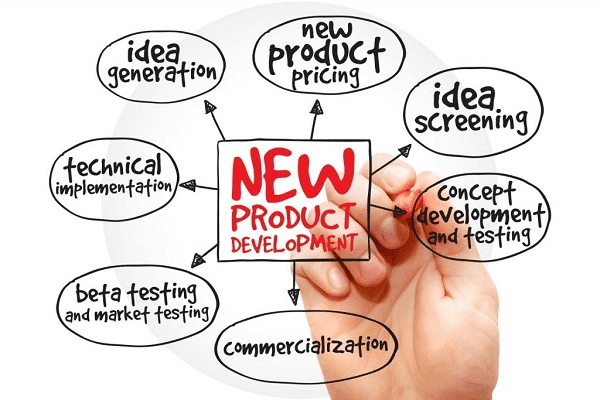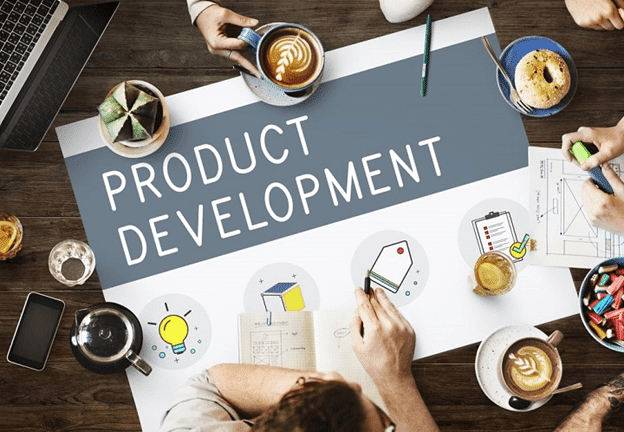In the process of developing** a product development strategy**, market research plays a crucial role. Market research helps businesses understand the needs, desires, preferences, and consumer trends. By collecting and analyzing information from customers, businesses can identify the essential criteria that the product needs to meet to satisfy customer expectations.

The Significance of Market Research:
-** Identifying Customer Needs and Demands:** Market research helps businesses understand the needs and demands of customers. This helps businesses create suitable products that meet customer expectations.
Analyzing Competitive Rivals: Market research helps businesses learn about competitive rivals in the same industry. Analyzing competitors helps businesses identify their strengths and weaknesses, enabling the creation of products with a competitive advantage.
Shaping Development Strategy: Based on market research results, businesses can shape a suitable product development strategy. This helps businesses focus on developing products with potential and meeting market demands.
Forecasting Market Trends: Market research helps businesses forecast future market trends. This helps businesses plan and develop products that align with market trends.
Industry Analysis
Analyzing the industry is a crucial step in the product development process. Understanding competition and development trends in the industry helps businesses shape an appropriate strategy and seize business opportunities. Additionally, industry analysis helps businesses position their products to differentiate from competitive rivals.
The Significance of Industry Analysis:
Understanding Competitive Rivals: Industry analysis helps businesses understand competitive rivals in the same industry. Thus, businesses can assess the strengths and weaknesses of rivals and develop products with a competitive advantage.
-** Seizing Business Opportunities:** Industry analysis helps businesses identify business opportunities within the industry. This enables businesses to focus on developing products with potential and bringing business advantages.
Product Positioning: Industry analysis helps businesses position their products in the market. Product positioning assists businesses in creating a unique selling proposition compared to competitive rivals and attracting customer attention.
Identifying Industry Development Trends: Industry analysis helps businesses identify industry development trends. This helps businesses prepare development plans and leverage opportunities from these trends.
Product Idea Development

After gathering information from market research and industry analysis, businesses have a foundation for developing new product ideas. The product idea needs to be evaluated for feasibility, innovation, and market potential. This process includes steps such as creating a product concept, designing prototypes, and conducting test trials to ensure that the product idea meets customer requirements and can be implemented in reality.
_ After gathering information from market research and industry analysis, businesses have a foundation for developing new product ideas. The product idea needs to be evaluated for feasibility, innovation, and market potential. This process includes steps such as creating a product concept, designing prototypes, and conducting test trials to ensure that the product idea meets customer requirements and can be implemented in reality.
The Significance of Product Idea Development:
Creating New Products: Developing product ideas helps businesses create new products that meet market needs. This is essential to ensure competitiveness and survival in an increasingly competitive business environment.
-** Innovation and Breakthrough**: The process of developing product ideas requires innovation and breakthroughs. Businesses need to find unique and distinctive ideas to create valuable and appealing products to customers.
Evaluation and Testing of Product Ideas: Developing product ideas requires evaluation and testing. Through this, businesses can ensure that the product idea meets customer requirements and can be implemented in practice.
Product Marketing
After the product is completed, businesses need to implement marketing activities to bring the product to the target customers. Marketing activities include building advertising campaigns, placement, distribution, and creating brand awareness. The goal of marketing activities is to reach the target customers, generate interest, and provide benefits for the product.
The Significance of Product Marketing:
Building Trust and Brand Recognition: Marketing activities help businesses build trust and brand recognition in the minds of customers. Creating interest and benefits for the product helps businesses attract the target customers.
Reaching Target Customers: Product marketing helps businesses reach and send information about the product to target customers. This helps businesses create awareness and interest from customers.
Creating Differentiation and Competition: Marketing activities help businesses create differentiation from competitive rivals. Through this, businesses can attract and retain target customers.
Building a Flexible Product Development Strategy

The product development strategy needs to be flexible and adaptable to every change in the market. Businesses need to constantly update and reevaluate their strategy to ensure that the product remains suitable for customer requirements and provides business benefits. Innovating and improving products is also a crucial factor in maintaining competitiveness in the market.
Significance of a Flexible Product Development Strategy:
Adapting to Market Changes: A flexible product development strategy helps businesses adapt to market changes. This helps businesses maintain competitiveness and survive in an increasingly challenging business environment.
Updating and Reevaluating Strategy: A flexible product development strategy requires businesses to continuously update and reevaluate their strategy. This helps businesses ensure that the product remains suitable for customer requirements and provides business benefits.
Innovation and Product Improvement: A flexible product development strategy encourages businesses to innovate and improve products. This helps businesses maintain competitiveness in the market and avoid falling behind new trends.
Conclusion
Product development strategy plays a crucial role in introducing new products or improving existing ones. Through market research, industry analysis, product idea development, and marketing, businesses can create products that meet the needs of target customers and compete in the market. However, a product development strategy needs to be flexible and innovative to adapt to market changes and meet the evolving needs of customers.











